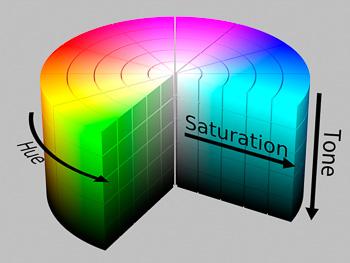
Dominican Amber Occurs in a very large variety of colors
What is a Color ?
Dominican Amber Occurs in a very large variety of colors which are often resumed to yellow, orange, green, blue…..etc. But before diving on Colors of Amber, we need to talk about Colors in General and Colors in the Gem World in Particular.
In Fact, color system is actually quite a bit more complex that it actually looks-like and in order to describ a color, professionals of the Gem Industry use a standard combination of 4 components, Body Color, Hue, Tone and Saturation.
Bodycolor: A Gem Material Basic Color determineted by it’s Selective Absorption of Light
Hue: The basic color we see on a Gem at first sight, most people refering about « Color » are actually talking about Hue.
Tone: Refers to the lightness or darkness of a Hue
Saturation: Refers to the Hue’s intensity
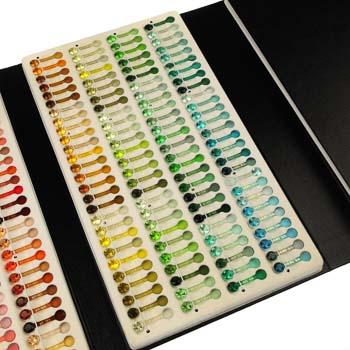
Gemset by GIA & Pantone
Determination of a Color in the Gem Industry
Industry specialised in Colored Gems use specific tools to determine the color of a specific Gem Material. One of the most refered tool is the "Gemset" designed by Pantone and The Gem Institut of America (GIA). Various "Gemsets" versions was available at GIA, the full set including 324 samples on a three trays storage case. Color Comparators was rounded on a side and had a faceted shape in the other side, this in order to offer a more realistic representation of color than any flat surface. Discontinued now, "Gemset" still be used by many Laboratory Professionals as well as schools and had turned now a collectionable instrument very researched. In our modern days, Computarised systems like Gemewizard are able to identify 1116 colors classifying 31 Hues on six Tones and six levels of saturation
Because Colored Gem Materials are so varied and subject to individual perception, the Gem Industry enhance Grading Rules in order to Classify an individual Colored Gem Material.
The Hue Wheel: A 31 Hue wheel based on the 7 main Hue's – Red Orange, Yellow, Green, Blue, Violet and Purple. (Pink & Brown are not included in the Hue Wheel and as refered as "Exceptional Hue's" in the Hue Chart)
The Tone Scale: A Reference using 11 Tones from Colorless to Black. As standard, the industry only use 7 of them from Very Light to Very Dark Classification.
The Saturation Scale: Gradueted from 1 to 6 - 1 to 3 being the lower grade. Two scales are used for the saturation evaluation, one for the warm colors and one for the cool colors.
A typical notation results of this Grading System
(Hue Code) Tone Degree/Saturation Index
A Colored Gem with the formule yG 4/5
will be interpreted as yellow-Green
with a Dark Tone and a Strong Saturation
(the capital letter refering to the Dominant Hue)
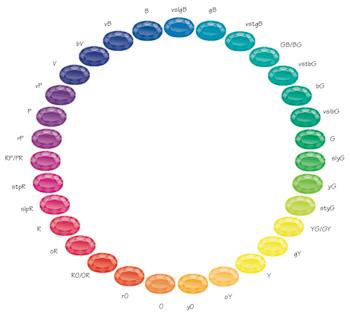
Hue Wheel
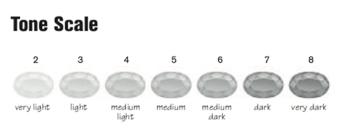
Tone Scale
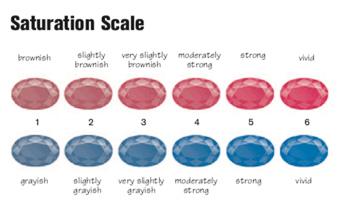
Saturation Scale
Phenomenal Gems
Most of Gem Materials Colors varies Slightly according to light conditions. Some of them exhibit unusual optical effects and are qualified for this reason by the industry as Phenomenal Gems.
Common Optical Effects on Phenomenal Gems are
Iridescence: Rainbow-like colors (Labradorite)
Asterism: The Star Effect ( Depends Mostly of the Quality of Cut, Sapphire, Ruby Chrysoberyl…)
Adularescence: Shimmering effect (Moonstone) Play of Colors (Opal)
Chatoyancy: Cat Eye Effect (Chrysoberyl, Apatite, Tourmaline on Cabochon Cut Shape)
Flame: Stombus Gigas Calcaceous Concretions (Conch Pearls)
Color Change: We are not talking here about changes only visible by expert like for color grading but Dramatic color changes obvious even to untrained eyes. Alexandrite (Chrysoberyl), Diaspore, Fluorite as well as some variety of Garnets and Sapphire.
Usambara Effect: Also Called « Emerald Filter Effect » is the effect in which Color varies according to the Light Path Lenght. This is a particular property of Amber, but has been observed also in some Garnets as well as in Tourmaline Specimens in which it depend specially of the type of cut.
Related Articles